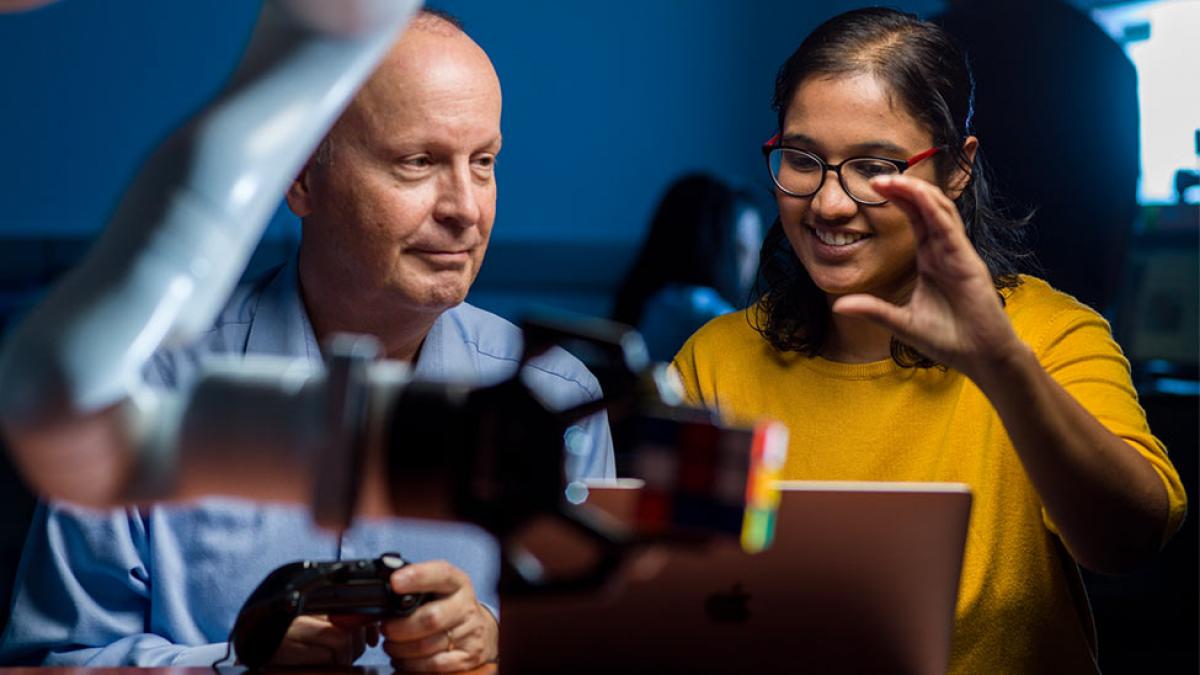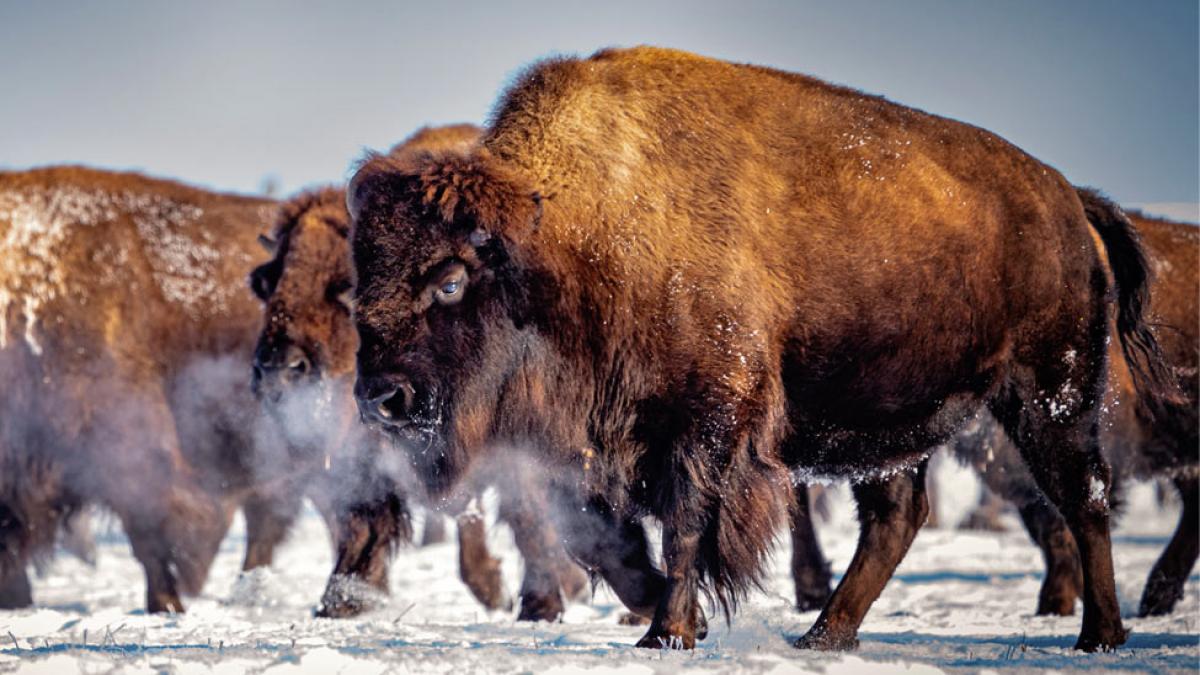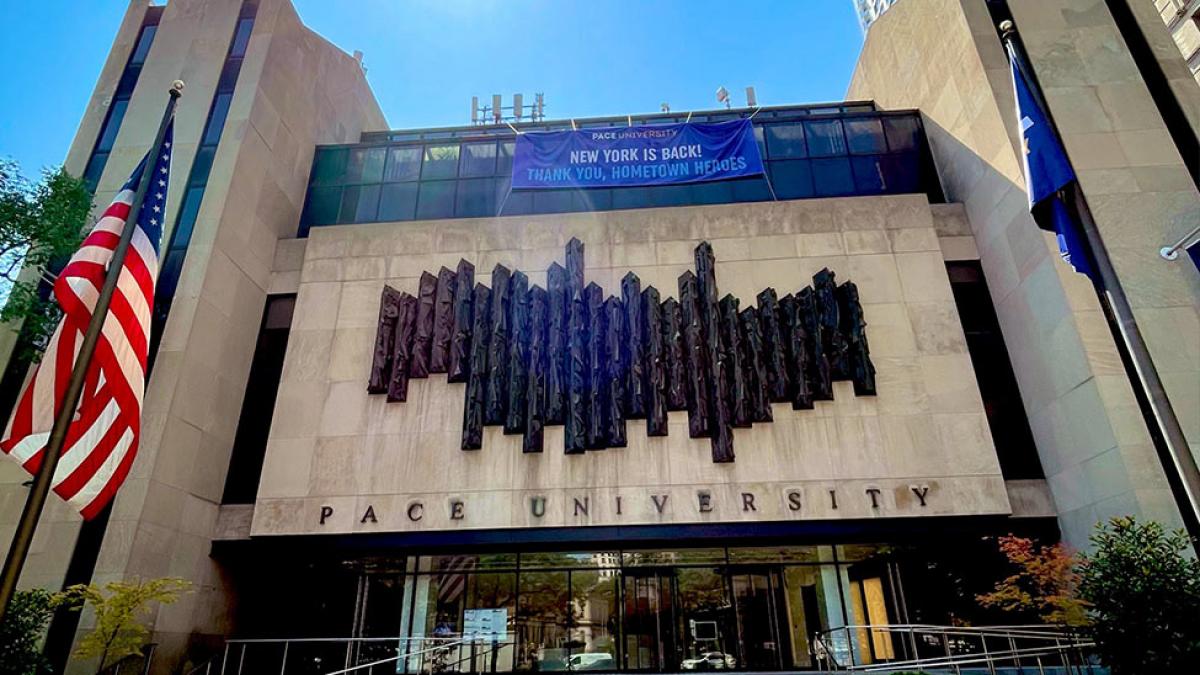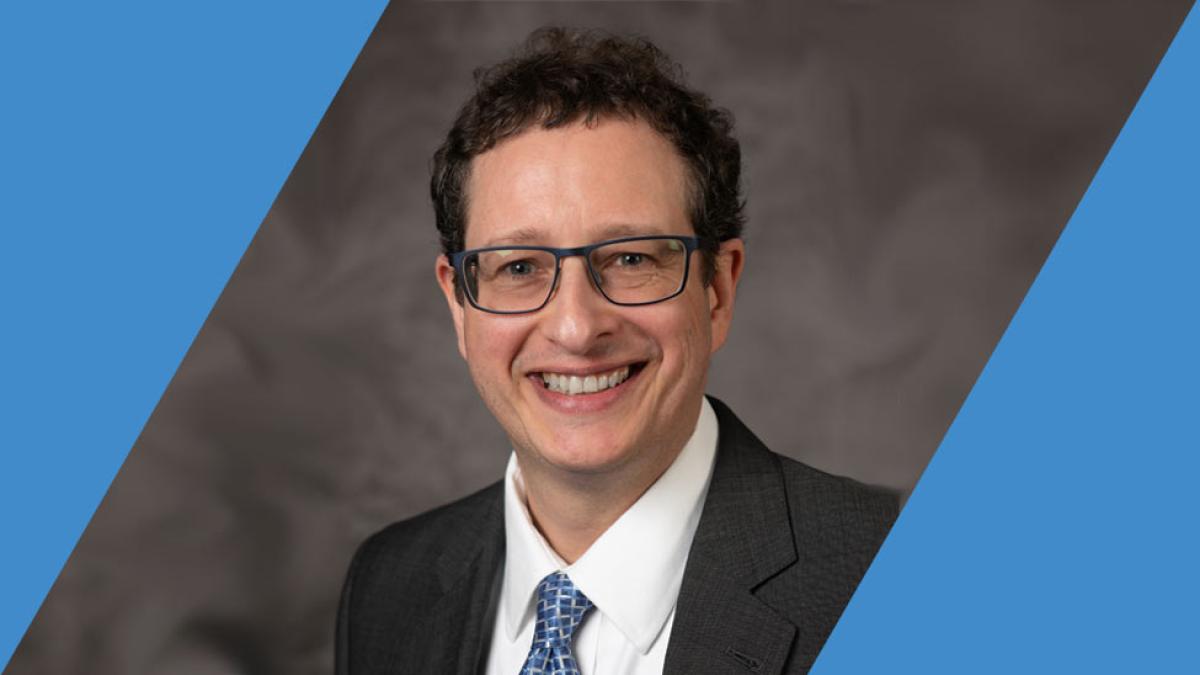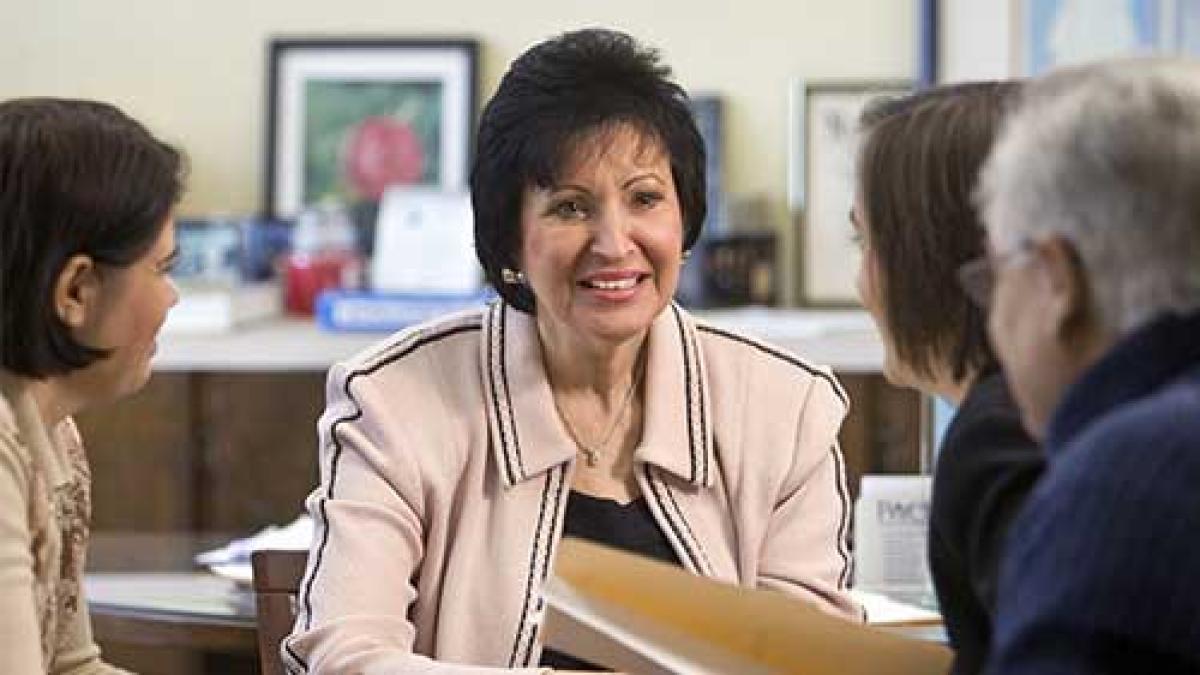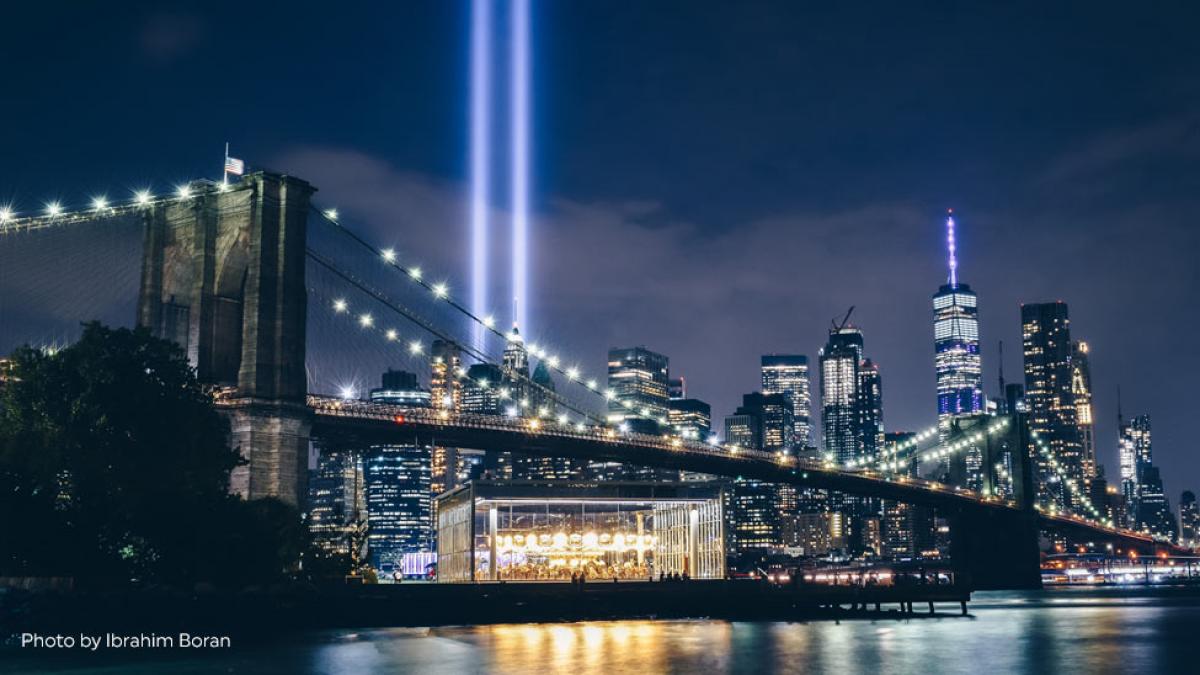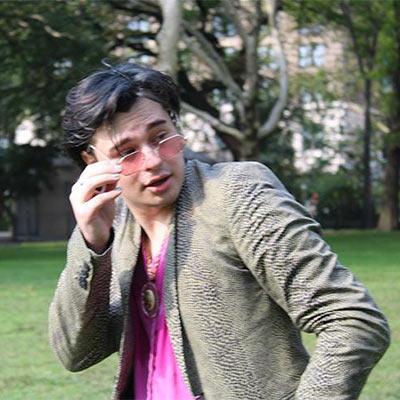
Coming into Focus
BFA in Art student Christian Solar ’23 is taking a deeper look at the decay of technology and the intersection of when the past becomes the present in his new exhibit Digital Distorted, on view until October 30 at the Pace University Art Gallery.



“All of the photos in the exhibit are completely unedited,” says Christian Solar ’23. “I really want to make that clear, because when you see them, they look crazy.”
The images, which are part of Christian’s Digital Distorted exhibit at the Pace University Art Gallery, were captured on a semi-vintage (circa 2008) Kodak EasyShare camera that had originally belonged to his mother.
“It feels like such a stroke of luck,” Christian says about his exhibit. He had been working on some images and shared them with Gallery Director Sarah Cunningham who saw an opportunity to develop his work into a cohesive exhibit. He went after the opportunity in full-force.
“You look at the photo and video quality and you can pinpoint that this looks like early-2000s footage and it puts you back into that headspace,” he explains. “Even if I’m shooting really recent things, it still gives that feeling.”
“This camera is actually broken—certified broken,” he laughs. “I started using it because it gave me these surprise organic results. You never know what you’re actually going to end up with; I can’t predict it and it’s almost like a filter.”
Even though Christian’s cameras aren’t even 20 years old, in the world of digital media, they are vintage. There’s a distortion and fuzziness and a certain look that the cameras of 2021 just aren’t able to give. Plus, just take a look at Instagram and TikTok, with faux light-leaks and pixelated filters abound. There’s an ineffable quality to the recent past and Christian is capturing it, one photo and video at a time.
“You look at the photo and video quality and you can pinpoint that this looks like early-2000s footage and it puts you back into that headspace,” he explains. “Even if I’m shooting really recent things, it still gives that feeling.”
The exhibit is purely aesthetics, and for Christian, that was the point.
“I was looking to make things that were visually engaging,” he says. “There isn’t necessarily a deeper meaning behind it. With the video, sure, I’m working in visual symbology, but this exhibit is really all about looking pretty.”
Christian’s work is on exhibit now through October 30, 2021, at the Pace University Art Gallery at 41 Park Row. On Friday, October 22, join Christian and other gallery artists for a special reception from 5:00 p.m.–7:00 p.m.
Westfair Online featured Haub Law Professor Cristina Buccola’s piece: “What employers in all industries need to know about cannabis law”
Haub Law Professor Cristina Buccola writes about what employers need to know about the cannabis law.
Haub Law Professor Cristina Buccola writes about what employers need to know about the cannabis law.
The New York Times featured Haub Law Professor Michael B. Mushlin’s piece: “Opinion | The Chaotic Conditions at Rikers Island”
Haub Law Professor Michael B. Mushlin writes about problems facing Rikers Island in the letters to the editor section of The New York Times.
Nechelle Nicholas '22
I have been able to participate in moot court competitions, the Federal Judicial Honors Program, law review, and a few societies. The small class sizes are a plus in terms of grasping course content and having your professors know you by name.
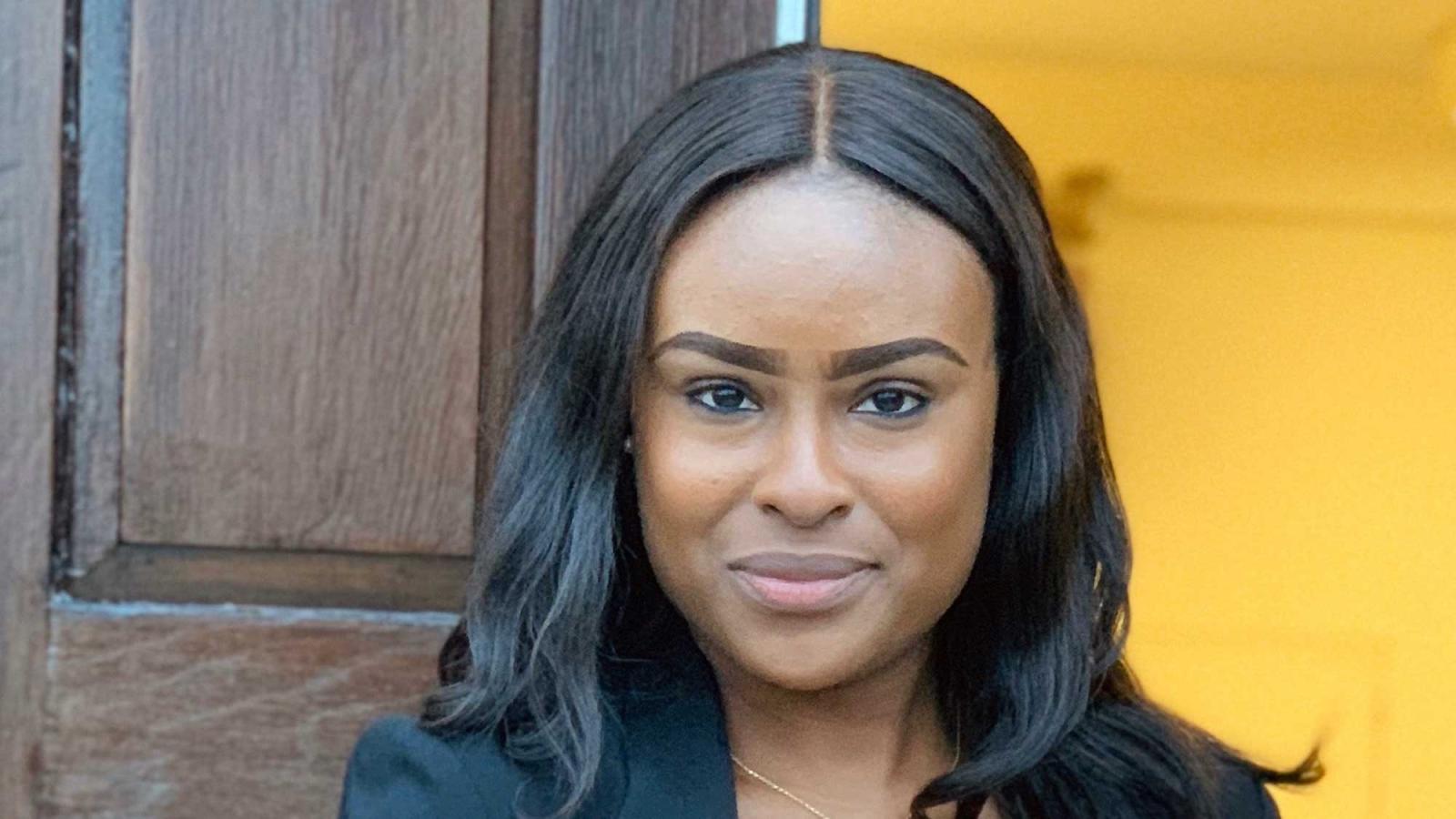
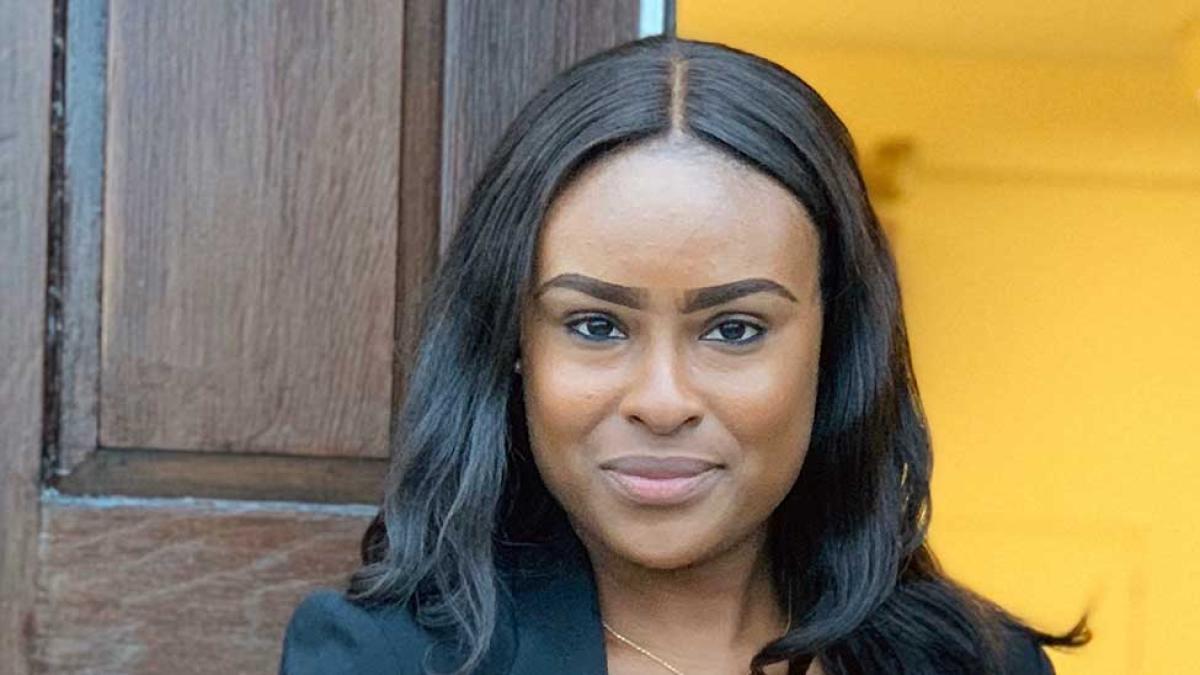
Let’s jump right in–how did you spend this past summer, as a rising 3L?
I was a summer intern at Black Marjieh & Sanford LLP. It was a great experience. I had the opportunity to complete assignments in many different aspects of insurance defense. On one day, I was preparing summaries of depositions and medical records. On another day, I was observing depositions, conferences, and was even asked to give feedback on case-strategy. I was also able to draft discovery demands, responses, and motions.
What do you feel you gained from your summer experience?
I definitely gained more practical legal experience, which was my goal for my 2L summer. I began the internship with little knowledge on insurance law and have left with a lot of valuable experience. I saw concepts such as negligence, service of process, and summary judgment at work, and analyzed them in current cases.I also sharpened my legal writing skills.
What activities are you involved in at Haub Law?
I am an Articles Editor on the Pace Law Review, where I lead a group of Junior Associates weekly. My law review note surrounding the Eighth Amendment and ICE detainees in the COVID-19 crisis will be published in the upcoming volume. Also, I am the Public Relations Chair for the Black Law Students Association (BLSA) and will be competing with the BLSA Mock Trial team. Along with those positions, I am a 3L Rep for the Women’s Association of Law Students.
Do you have a specific area of law you are focusing on or know what you hope to do upon graduation?
I am still undecided, but I plan to graduate with the Corporate Law Path to Practice. I have developed a strong interest in litigation, so I hope to do some type of litigation upon graduation, whether it is commercial litigation or in the public interest sphere.
What would you say about your Haub Law experience?
It has been great. I have been able to participate in moot court competitions, the Federal Judicial Honors Program, law review, and a few societies. The small class sizes are a plus in terms of grasping course content and having your professors know you by name. Also, the ability to participate in various externships and programs has helped me to see explore various areas of the law, while still figuring out what I would like to do upon graduation. The non-competitive atmosphere has allowed me to thrive academically and socially, as everyone wants to see you do great.
Leadership Letter: Fall 2021
In spite of the pandemic, Pace is marching ahead. With the continued transformation of the NYC Campus, new interdisciplinary academic programs, and a bright look to the future, Pace continues to thrive.
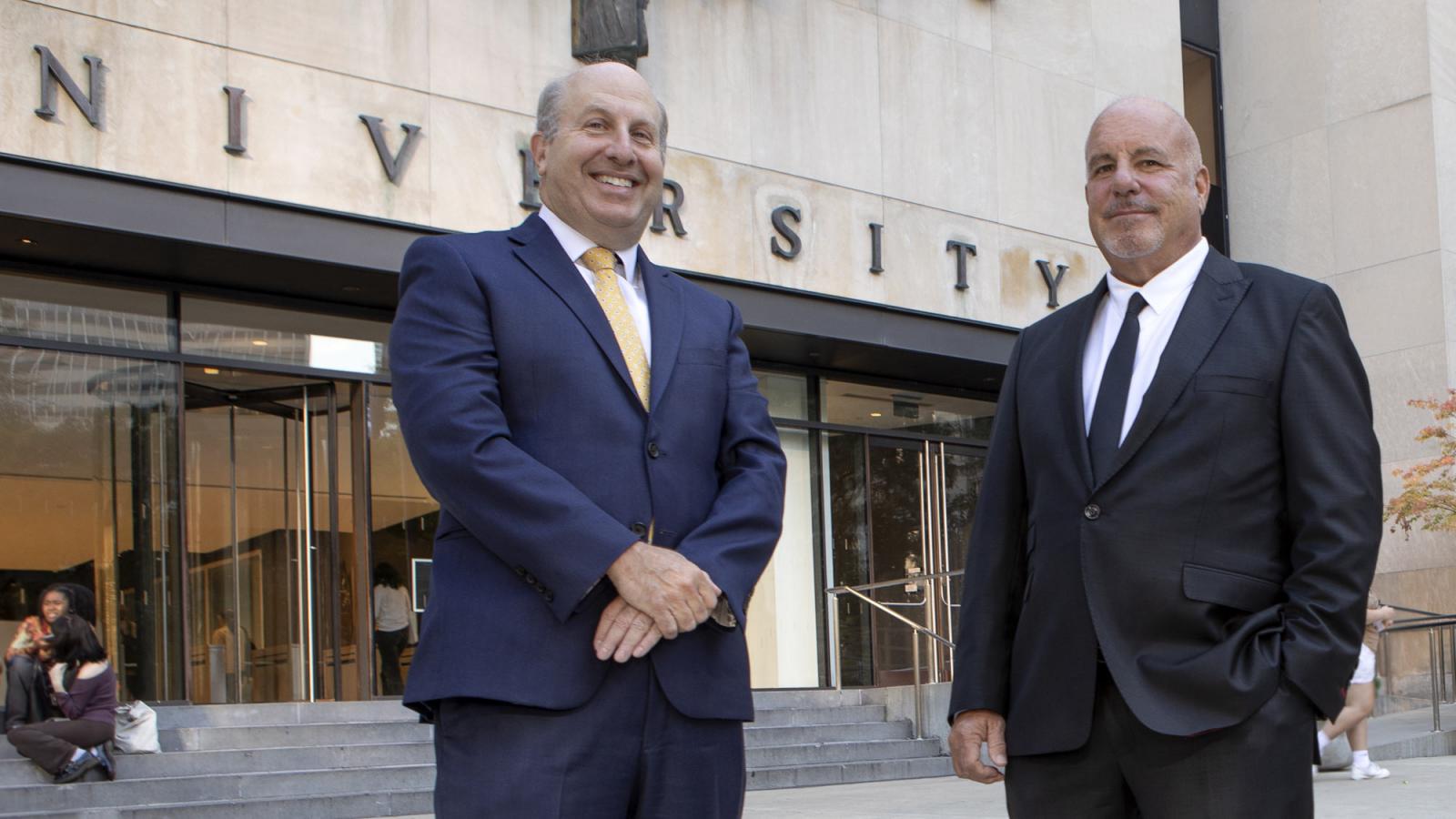
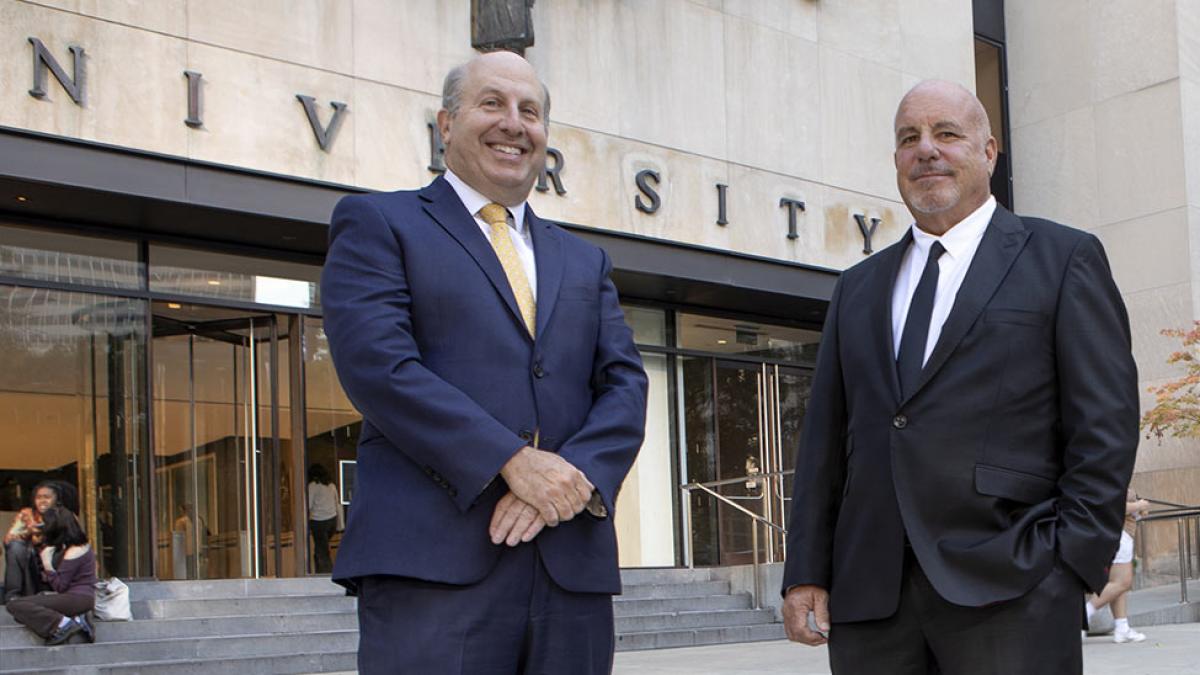
New York City and Westchester have come back to vibrant life.
Sidewalks are busy, people are out, Broadway and other performances have restarted. We’re all still careful, and we’re all observing health and safety protocols, but in our highly vaccinated region, and on our vaccine-required campuses, things are feeling much more normal.
“New York Forever,” say the banners hanging all around the city. To which we can only respond: Pace Forever.
This year, we enrolled the biggest class of new undergraduates in at least 20 years (and possibly ever). We also enrolled more new graduate students than we have in years (and also possibly ever). And at Haub Law we enrolled more students than we have in 15 years. Our residence halls are full. Our campuses are bustling. It’s exciting to once again have to wait for busy elevators in One Pace Plaza!
We’re marching ahead with our transformation of the New York City Campus, with three floors of brand-new classrooms, including a new home for the Lubin School of Business, now open on the west side of One Pace Plaza. Work is underway for 15 Beekman Street, which will include a new residence hall to replace Maria’s Tower, new community spaces like a dining hall and library, and new learning spaces, including a dedicated home for the Seidenberg School of Computer Science and Information Systems. And we’re developing plans for an expanded new home for Pace Performing Arts.
In Pleasantville, we’re moving ahead with plans for a state-of-the-art new Healthcare Hub serving students in the College of Health Professions. We also renamed the former Wright Cottage in honor of CHP dean emerita Harriet Feldman (who is now our first-ever chief wellness officer).
And we’re starting to implement our new Strategic Plan, Pace Forward. We’re introducing new programs to meet the needs of today’s students and employers, like master’s degrees in health informatics, cybersecurity, and human-centered design and a new badge in human rights advocacy.
Finally, we’re pleased to be embarking on our new leadership partnership together, with Rob in his first semester as chair of Pace’s board of trustees and Marvin reappointed by the board this summer to another five-year term as president.
There’s a lot going on here at Pace. Together with you, we’re honored to be building this strong and successful future.
Let’s go get it,
Marvin Krislov
President
Rob Sands ’84
Chairman of the
Board of Trustees
More from Pace Magazine
At the intersection of Pace’s strategic priorities and opportunities for outstanding academic growth comes the drive to move Pace forward. We're meeting the challenges facing higher education and putting our unique positioning and competitive advantages to work, strengthening our reputation as we move into the future.
Dyson Biology Professor Melissa Grigione, PhD, has spent her career traveling all around the world to better understand a wide range of animal populations. She's now passing on what she's learned to the next generation.
The Office of Alumni Relations is excited to announce the brand new Pace University Alumni Association. Pace alumni are an extraordinary community of advocates, entrepreneurs, thinkers, creatives, and more. The Association is the vehicle that allows you to connect with these community members.
Pace's New Alumni Association
The Office of Alumni Relations is excited to announce the brand new Pace University Alumni Association. Pace alumni are an extraordinary community of advocates, entrepreneurs, thinkers, creatives, and more. The Association is the vehicle that allows you to connect with these community members.
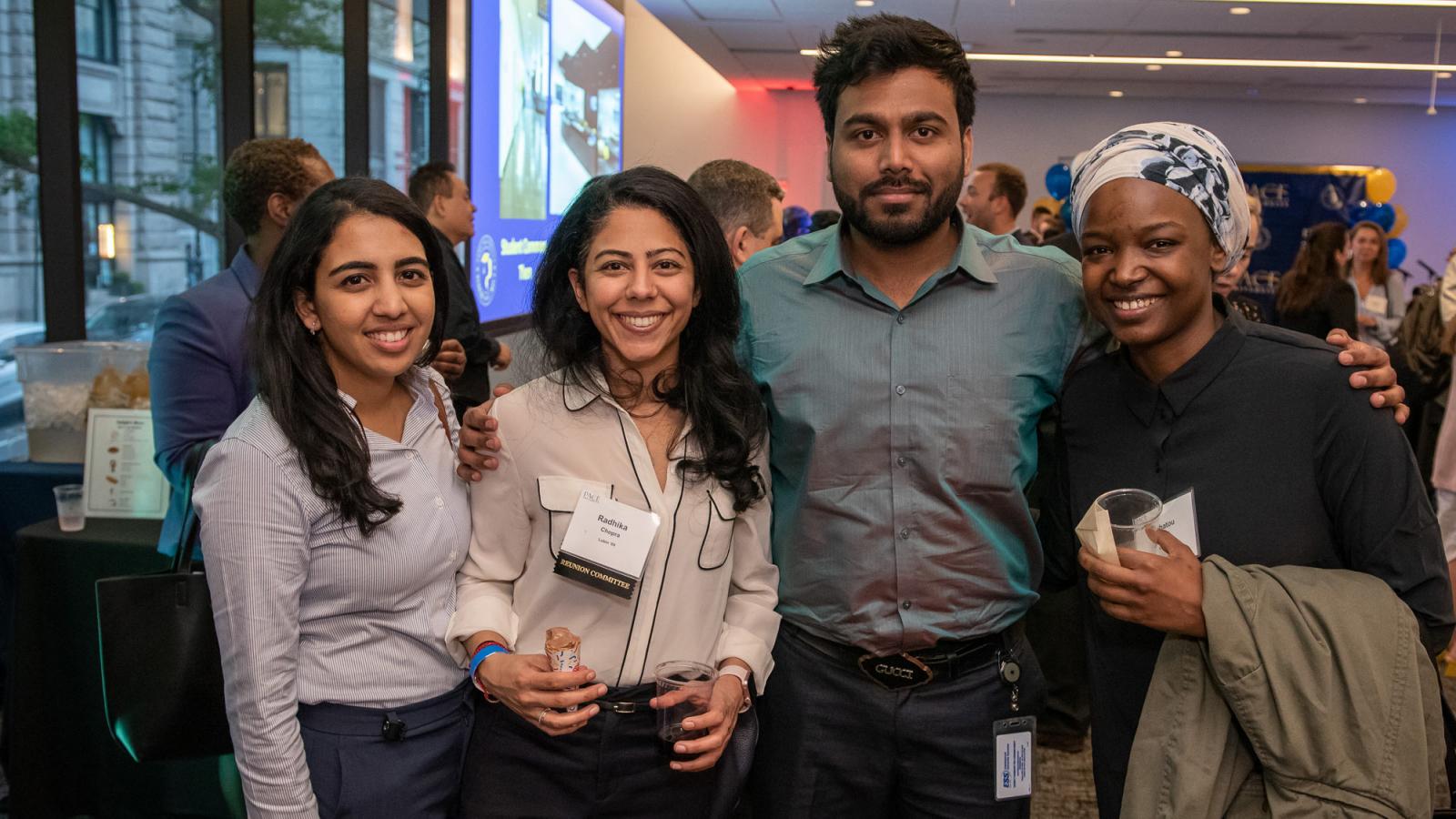
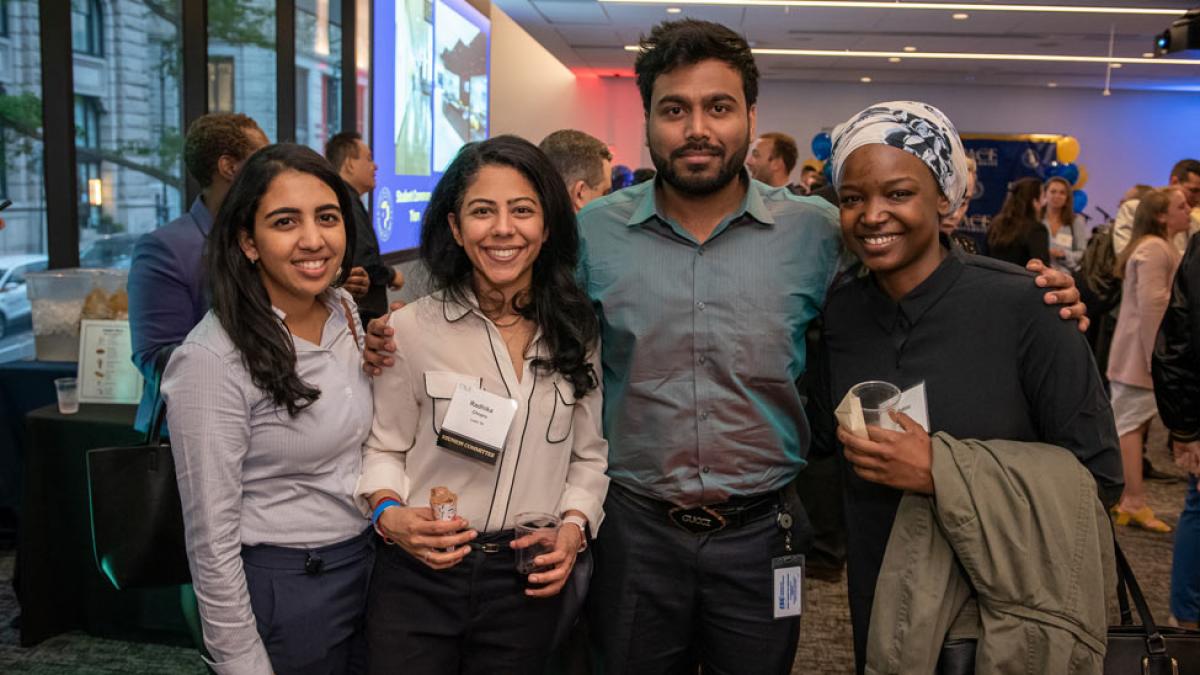
The Office of Alumni Relations is excited to announce the brand new the brand new Pace University Alumni Association.
In November 2019 the Office of Alumni Relations conducted an all alumni survey. From that survey we learned that Pace alumni wanted to be involved in the life of the University but felt as if they had not been given the tools to do so. The Association was created to do just that, to give Pace alumni the tools to better their alumni experience and, most importantly, have a voice.
On September 23, 2021 the Pace University Alumni Association was officially launched. At the helm of the Association serving in the roles of Chair and Co-Chair are Sabrina Griffin ’92 and Kelly Herbert ’06. Both of these extraordinary women are strong leaders in the Pace alumni community. They understand the gravity of taking on these inaugural leadership roles and are committed to the mission of making the association an inclusive place where all Pace alumni can find a home.
“One of my main goals is to help build that bridge from Opportunitas as a student to Opportunitas as an alumnus. You are not alone in this. You might be the first in your family to go to college, but you have a family of college education folks who are in your network, who are here to help and support you for as long as you’re here,” says Kelly Herbert. “That’s what I hope this alumni association really communicates: you are not alone, and you are inheriting a diverse, accomplished network of people who are ready and willing to help.”
In addition, we’ve created several avenues for volunteering in meaningful ways. Whether that be through a school oriented committee, our Graduates of the Last Decade committee, or one of our affinity committees. Alumni are now given additional opportunities for meaningful engagement. Being that the Association is meant to grow and change, the committees will also follow suit. As more alumni become involved and seek additional opportunities, we will continue to build committees and diversify our volunteer options.
Now, you may be asking what’s next. Well, all alumni are automatic members of the Association. No paperwork needed to join. Pace alumni are an extraordinary community of advocates, entrepreneurs, thinkers, creatives, and more. The Association is the vehicle that allows you to connect with these community members.
Get involved now and learn more about the opportunities available to you as part of the Pace University Alumni Association.
More from Pace Magazine
This summer, Pace's digital presence got a makeover, resulting in a new-and-improved website that directly aligns with Pace's strategic priorities.
Pace’s second annual Social Justice Week begins on October 25, 2021. This week of learning and reflection is designed to offer an ongoing memorial for Pace student Danroy “D” Henry, and to further commit Pace University to social justice and anti-racism.
Leading the way forward-looking academics, moving up in the rankings, and showing that New York has massive heart, here are our top 10 things to inspire you.
Prestigious 2020–2021 Elisabeth Haub Award for Environmental Law and Diplomacy Presented to Two Global Advocates During an Inspiring Ceremony and Panel Discussion
The Elisabeth Haub School of Law at Pace University has conferred the 2020–2021 Elisabeth Haub Award for Environmental Law and Diplomacy on Ugandan climate justice advocate Vanessa Nakate and Professor Wang Xi, an environmental law scholar and advocate with Kunming University of Science and Technology in China.
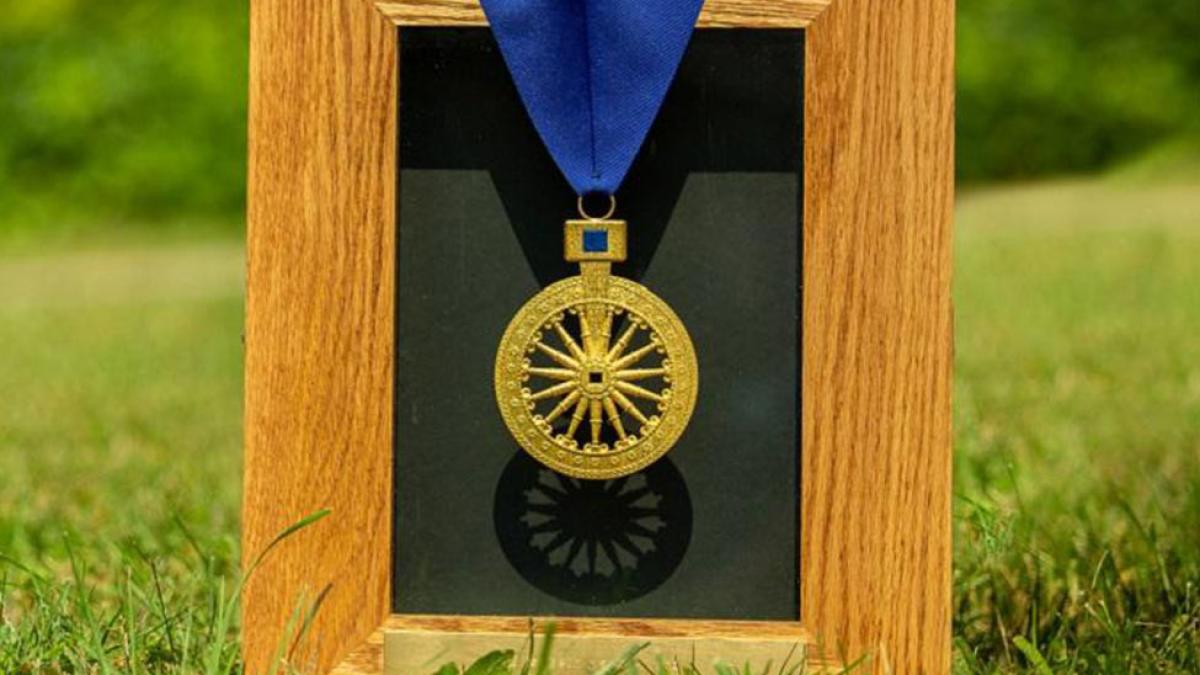
The Elisabeth Haub School of Law at Pace University has conferred the 2020–2021 Elisabeth Haub Award for Environmental Law and Diplomacy on Ugandan climate justice advocate Vanessa Nakate and Professor Wang Xi, an environmental law scholar and advocate with Kunming University of Science and Technology in China.
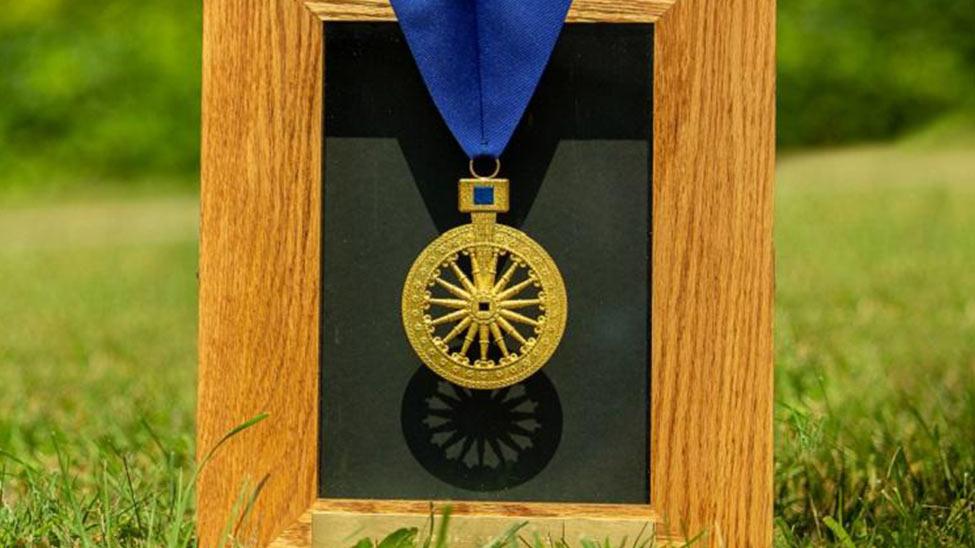
The award ceremony was presented virtually on Tuesday, October 12, 2021 to participants from across the globe and was preceded by a panel discussion led by Smita Narula, Haub Distinguished Professor of International Law, with the distinguished laureates.
This year’s award highlighted the inter-generational nature of leadership in the environmental realm by showcasing the advocacy and impactful work of both award recipients, who have uniquely served to protect the environment and advance climate justice.
“We are honored to have the opportunity to award the 2021 Elisabeth Haub Award for Environmental Law and Diplomacy to two individuals who have worked tirelessly in different ways and in different parts of the world to defend the environment,” said Horace E. Anderson Jr., Dean of the Elisabeth Haub School of Law. “As the nation’s number one ranked program in environmental law, we are committed to training students to understand the intersection between climate justice, the environment and the law. These recipients serve as inspiring role models for driving global change in our environment.”
Twenty-four year old activist and author Vanessa Nakate has drawn global attention to the impact of climate change on poverty, hunger, disease, conflict, and violence against women and girls. She is the first Ugandan national to receive the Haub Award and also the youngest recipient of the award to date. Nakate has spearheaded climate change activism in Africa, green projects and education in schools across the continent, and led a global campaign to save Congo’s rainforest, which is facing massive deforestation. Through her innovative efforts on the frontlines, her work has inspired other countries in Africa and Europe to address the climate crisis.
Nakate addressed an incident that occurred early in her journey as a climate justice advocate when she was cropped out of a photo taken by the Associated Press at the World Economic Forum in Davos, Switzerland. The incident received global attention and, according to Nakate, pointed to a wider issue of erasure of African voices in climate action conversations.
“It wasn’t just about a picture being removed from the conversation,” said Nakate. “It was a message being removed – a story being removed. Every activist has a story to tell, every story has a solution to give, and every solution has a life to change. We can only have climate justice if it includes everyone. But erasure of voices and stories of activists will not enable us to have climate justice. We have to include every voice and every community.”
Asked what she would like to see happen at the next global climate summit set to take place in Glasgow next month, Nakate replied, “Leaders must understand that we cannot eat coal, we cannot drink oil, and we cannot breathe so called natural gas. What I would like to see is real action that prioritizes the lives of the people and our planet.”
Professor Wang Xi attributes his passion for the environment to his childhood, stating that his parents instilled in him the value to become a “person useful for society.” He refers to his discovery of comparative literature during his studies as an “aha moment,” driving his curiosity to study environmental protection.
After China started to reform and open up in 1978, Professor Wang Xi became an academic and was instrumental in the development of Chinese environmental law, a new area of growing importance. He has since been a key influencer in a major revision to China’s framework environmental protection law, which was accepted and adopted by the Chinese National Congress in 2014.
Professor Wang Xi notes that China must take immediate next steps in furthering the advancement of environmental law nationally and internationally, as a party to numerous multilateral environmental agreements. He shared that he is now currently engaged in advocating for a new version of the law on environmental impacts assessment, taking into consideration the unforeseen challenges that the climate change and the COVID-19 pandemic has presented.
“This pandemic has reminded every human being to respect nature,” he said. “We need to update and revise our laws. We suggest that new environmental impact assessment (EIA) laws should cover the issue of climate change, biodiversity and pathologic disease.”
The Elisabeth Haub Award for Environmental Law and Diplomacy is the world’s most distinguished award in the field of environmental law. The award was created in 1997 by the Elisabeth Haub School of Law at Pace University, in cooperation with the Haub Family, to honor the legacy of Elisabeth Haub (1899 – 1977), a noted philanthropist and advocate for strong laws for the conservation of nature. The award is chosen annually by an esteemed jury of leaders in environmental law and was first established to commemorate the 25th anniversary of the United Nations Stockholm Conference and the 5th anniversary of the United Nations Rio de Janeiro Earth Summit.
“The Elisabeth Haub Award for Environmental Law and Diplomacy was established to recognize the innovation, skill, and accomplishments of lawyers, diplomats, international civil servants and other advocates who work to create the world environmental order,” said Liliane A. Haub, environmental advocate and Pace University Trustee. “We are pleased to honor two individuals whose inspiring work is making a global impact in our fight to create a more sustainable planet.”
Learn more about the 2020–2021 award recipients and watch the video of the 2020–2021 ceremony and panel discussion below.
Social Justice Week 2021
Pace’s second annual Social Justice Week begins on October 25, 2021. This week of learning and reflection is designed to offer an ongoing memorial for Pace student Danroy “D” Henry, and to further commit Pace University to social justice and anti-racism.


Pace’s second annual Social Justice Week is taking place the week of October 25. This week of learning and reflection is designed to offer an ongoing memorial for Pace student Danroy “DJ” Henry, and to further commit Pace University to social justice and anti-racism.

During the summer of 2020, Pace alumni, students, staff, and faculty, in consultation with the Henry family, conceptualized Social Justice Week as a way to honor DJ’s life and acknowledge the connections between his story and racial injustice. DJ Henry had a passion for people and sports. He was a student on Pace’s Pleasantville Campus and a member of the football team. On October 17, 2010, Pace's Homecoming weekend, DJ was shot and killed by a Pleasantville police officer. DJ's family founded the DJ Henry Dream Fund to carry on his legacy and passion for youth sports. To learn more about DJ, visit the DJ Henry Dream Fund, view this video from the DJ Henry Dream Fund, view this video from CBS News, or read this comic strip.
Held to coincide with DJ’s birthday, October 29, Social Justice Week is a community-driven effort that understands that DJ’s story cannot be told accurately without acknowledging how it is connected to the history and present-day reality of white supremacy and racism. The week aims to offer original programming that adheres to values of equity and justice and engages the campus community in learning activities and dialogue centered on the issues of social justice. Social Justice Week seeks to create brave spaces that challenge white supremacy and racism, among other forms of oppression, and to create a starting point from which meaningful dialogue and action can be created for the entire Pace Community.
A full calendar of events is available below. All members of the Pace Community are invited to attend. For more information, contact the Social Justice Week Committee at socialjusticeweek@pace.edu.
Social Justice Week 2021 Calendar of Events
If you are interested in being part of the Social Justice Week 2022 planning committee, please email socialjusticeweek@pace.edu to be notified when applications open.
Event information, including location, is available below. If you have questions about an event, please contact the individual listed as the event’s primary contact. For general questions about Social Justice Week, please email socialjusticeweek@pace.edu.
- Sunday, October 24
- Monday, October 25
- Tuesday, October 26
- Wednesday, October 27
- Thursday, October 28
- Friday, October 29
Sunday, October 24, 2021
Drive-In Movie: Get Out
6:00 p.m. | Parking Lot D behind Willcox Hall | Pleasantville Campus
Questions? Contact Irach'e Teague at it96578n@pace.edu.
Join us for a screening of Jordan Peele's Get Out. During the movie, the Resident Assistants from the Townhouses and Elm Hall communities will be serving hot chocolate, bagged popcorn, candy, and other snacks to those in attendance. The proceeds from snack and drink purchases will be sent to the DJ Henry Dream Fund.
Monday, October 25, 2021
Reading, Writing, and Racism: Combating Implicit Bias in the Classroom
10:00 a.m.–11:00 a.m.
Registration Required | Zoom info will be sent after you register.
Questions? Contact Laura Kaplan at lkaplan2@pace.edu.
Students and faculty from the Pace School of Education will examine how implicit bias and other microaggressions can occur in classroom teaching. Through case studies and role-playing, examples of classroom bias and microaggression will be simulated and unpacked. The goal of this interactive presentation is to share ideas and strategies for developing safe classroom learning spaces for all students.
Social Justice Week Information Table
New York City Campus: 11:00 a.m.–5:00 p.m. | One Pace Plaza, Tabling Hub.
Pleasantville Campus: 11:00 a.m.–4:00p.m. | Kessel Student Center.
Law School: 12:00 p.m.–2:00p.m. | Aloysia Hall
Questions? Contact the Social Justice Week Committee at socialjusticeweek@pace.edu.
Stop by the Social Justice Week table to learn more about the week’s events and pick up freebies. Individuals who show proof of donation of at least $10 to the DJ Henry Dream Fund will also receive a commemorative t-shirt.
Artists Talk by Alberto Lule
12:10 p.m.–1:10 p.m. | 41 Park Row, Room 202 | NYC Campus
Questions? Contact Sarah Cunningham at scunningham@pace.edu.
As part of the Substance exhibit and Social Justice Week, the Pace University Art Gallery and the Criminal Justice Department will co-host an artist talk by Alberto Lule, an artist who uses readymades, mixed media installations, and tools used by agencies of authority to examine and critique mass incarceration and the prison industrial complex in the United States, particularly the California prison system. Using his own experiences, he aims to tie the prison industrial complex to other American political issues such as immigration, homelessness, drug addiction, and mental health. He holds a BA in Art from the UCLA School of Arts and Architecture. His work was recently included in We Live, Memories of Resistance at the Oxy Arts Gallery at Occidental College and Language Games at the Fullerton College Art Gallery. In 2020, he was also the recipient of the Kay Nielsen Memorial Award from the Hammer Museum and a residency from Tiger Strikes Asteroid Los Angeles.
Pace Letters to Incarcerated Friends
3:00 p.m.–4:00 p.m. | One Pace Plaza, E320 | NYC Campus
Questions? Contact Danielle Harari at dh26927n@pace.edu.
Pace students are invited to write letters of support to individuals who are incarcerated across the US to bring them some light, humanity, and other support they may need for rehabilitation. Held every week, this program allows students to safely and meaningfully consider how to build connections with incarcerated communities. We will be collaborating with each other to make sure that our message to our friends is not self-serving but allows the inmate to take what they want out of the experience of speaking with us.
DJ Henry Mural Unveiling
4:00 p.m.–6:00 p.m. | Kessel Student Center | Pleasantville Campus
Questions about the mural unveiling? Contact Irach'e Teague at it96578n@pace.edu.
Questions about transportation to Pleasantville from other Pace campuses? Contact mcruztillery@pace.edu.
Please join us as we honor DJ Henry’s legacy with an unveiling of a mural created by Brittany S. Price and hear from special guest speakers.Transportation from the NYC and Haub Law campuses will be provided. To sign up for free transportation to Pleasantville from NYC or Haub Law, please sign up here. Please note, spots are limited and allotted on a first-come, first-serve basis.
The Importance of Voting
5:00 p.m.–7:30 p.m. | One Pace Plaza, Bianco Room | NYC Campus
Questions? Contact Andie Ironside at ai49526n@pace.edu
Ashmi Sheth will speak to Pace students about the importance of voter registration and getting your vote out. Voting can create important change one wants to see implemented in policy.
Collaborative Research with (not on) Indigenous Communities
6:00 p.m.–7:30 p.m.
Registration Required
Questions? Contact Anne Toomey at atoomey@pace.edu.
A talk by Armando (Mandu) Medinaceli, who works as the Indigenous Education Director for North American Traditional Indigenous Food Systems, on the importance of decolonizing research and doing collaborative research with (not on) indigenous communities. Mandu is a Bolivian ethnobiologist with over fifteen years of experience working in ethnobiology, indigenous foodways and food sovereignty, biocultural diversity, sustainability, climate change, community conservation, collaborative video, and more.
Movie Screening: The Killing of Kenneth Chamberlain
6:00 p.m.–8:00 p.m.
Registration Required
Questions? Contact Rachael Silva at rsilva@law.pace.edu
In 2011, Kenneth Chamberlain Sr., an elderly African American veteran with bipolar disorder, was killed during a conflict with police officers dispatched to check on him after his medical alert device was mistakenly activated in his home in White Plains, NY. Released in September, The Killing of Kenneth Chamberlain is a socially conscious drama thriller based on the true story of a case that Elisabeth Haub School of Law Professors Randolph McLaughlin and Debra Cohen have worked on for ten years. The film recounts the excessive and brutal force executed by the police in their response to this non-threatening situation and provides a lens for society to reflect on the reform needed in policing tactics and our social justice system.
Let's Be Frank #2: The Power of Meeting a Person
6:30 p.m.–8:00 p.m.
Zoom ID: 925 1017 1033 | Zoom Password: 711323
Physical Location: Willcox Hall, Multipurpose Room | Pleasantville Campus
Questions? Contact Corinna Sager at csager@pace.edu.
Culture and socialization play a huge part in who we become and how we look at others. Those who look differently, behave differently or have different values are quickly judged. But what happens if we meet a person? Professor Sager and former student Daniel Parker will host a roundtable of current and former students from different cultures and ask: “How can we harness our own cultural differences to create a better, safer world for all?
DJ Henry Memorial and Allyship Conversation with the Black Student Union
9:00 p.m.–11:00 p.m. | Kessel Student Center, Boudreau Lounge | Pleasantville Campus
Questions? Contact Luisa Gonzalez at lg04506p@pace.edu.
Come and join the Black Student Union (BSU) to discuss DJ Henry's memory and celebrate his life. In addition, come out and discuss how you can be an ally to the cause we are fighting for. Make sure you pop out wearing blue in support of it!
Tuesday, October 26, 2021
Diversity, Equity, and Inclusion Workshop
10:00 a.m.–12:00 p.m. | 41 Park Row, Room 202 | NYC Campus
Registration Required | Zoom info will be sent after you register.
Questions? Contact Gia Pham at gpham@pace.edu.
This session will provide participants with research-based strategies to challenge their daily practices and for being in solidarity with communities of color, especially in higher education.
DJ Henry Dream Fund Bake Sale
1:00 p.m.–3:00 p.m. | Kessel Student Center, Multipurpose Room | Pleasantville Campus
Questions? Contact Syd Reyes at sr42826p@pace.edu.
Cookies, cupcakes, sweet treats. Stop by for a goodie. Proceeds go toward the DJ Henry Dream Fund.
Diversity, Equity, and Inclusion Student Panel Discussion
1:15 p.m.–2:00 p.m.
Zoom ID: 974 8119 4469 | Password: 860725
Questions? Contact George Haddad at georgehaddad7@yahoo.com.
Four students of diverse backgrounds will discuss their stories, challenges, and discrimination they’ve overcome in a 45-minute student led panel.
FiDentity: A Racial Geography Tour of The Financial District
3:00 p.m.–5:00 p.m. | One Pace Plaza, Main Entrance
Questions? Contact Jared Keyes at jkeyes@pace.edu.
Join Residence Director Jared Keyes on a walking tour of the Financial District using a racial lens. We will be visiting several locations within the neighborhood of Pace’s NYC Campus to understand some of the history, growth, and change of our community over time. For participants unable to attend the in-person event, information and visuals will be provided for reference, or to conduct one’s own self-guided tour.
Bystander Intervention: Standing Up for Your Community
3:30 p.m.–4:30 p.m. | 41 Park Row, Room 202 | NYC Campus
Questions? Contact Juliette Verrengia at jverrengia@pace.edu.
Bystander intervention provides students with a framework and tools to intervene in situations that are harmful or potentially harmful, particularly related to the potential for sexual violence, dating violence, and identity-based discrimination or harm. Students will learn common barriers to intervention, strategies to stand up against harmful behaviors, and ways to create a healthier, safer community. Bystander intervention is social justice work on an interpersonal level.
COVID-19 and the Black Lives Matter Movement Oral History Project
4:00 p.m.–5:00 p.m.
Registration Required | Zoom info will be sent after you register
Questions? Contact Maria Iacullo-Bird at miacullobird@pace.edu.
HIS 196H “COVID-19 and Black Lives Matter: Comparative, Crisis-based Oral History in the American Experience” is a Fall 2021 civic engagement, public-history course that is studying the impact of the global pandemic COVID-19 and the Black Lives Matter Movement through oral history interviews and comparative analysis of 20th and 21st Century American History. For this course-based undergraduate research initiative which also is a digital humanities project, students are conducting oral history interviews to generate original testimony and knowledge about COVID-19 and the Black Lives Matter Movement. These interviews and related materials will become part of a project website that will be made available to the Pace Community and the larger public. Student presenters will introduce the oral history project and highlight the historical connections between disease and social justice struggles. Additionally, they will speak about the importance of “crisis-based” oral history and public history, and will invite individuals to be interviewed. The interviews will be scheduled after Social Justice Week.
Salary Inequity in the Workplace for Women and BIPOC Employees
5:00 p.m.–6:00 p.m.
Registration Required | Zoom info will be sent after you register
Questions? Contact Helene Cruz at hcruz@pace.edu.
Join us for this very special session with guest speaker and Pace alumna Temporary President and Majority Leader of the New York State Senate Andrea Stewart Cousins as she speaks about Salary Inequity in the Workplace for Women and BIPOC employees.
Discussion: The Killing of Kenneth Chamberlain
6:00 p.m.–7:00 p.m.
Zoom ID: 922 2957 4326 |Zoom Password: PACESJW
Questions? Contact Katherine Fink at kfink@pace.edu.
This session provides a space for people to react to the film The Killing of Kenneth Chamberlain and advance conversations about police violence, race, mental health, and intersectionality. Kenneth Chamberlain Sr.’s son, Kenneth Chamberlain Jr., has been invited to participate in this discussion. In addition to being a tireless advocate for his father, Kenneth Chamberlain Jr. is a founding member of the Westchester Coalition for Police Reform. The discussion will be facilitated by students in MCA 495, Digital Storytelling, who are reporting on the Kenneth Chamberlain Sr. and DJ Henry cases this semester.
Mingle Mingle: Practicing Pronouns
8:00 p.m.–9:00 p.m. | 33 Beekman, 2nd Floor Multipurpose Room | NYC Campus
Questions? Contact Meagan Mullen at mmullen2@pace.edu.
"Hi! My name is ___ and my pronouns are ___, nice to meet you." Have you heard someone at Pace introduce themselves this way? Did you not understand or know how to respond? That’s okay! It’s helpful to share pronouns to people you haven’t met so they know how to refer to you when you aren’t around, and this is a practice we’ve grown accustomed to at Pace University. This isn’t natural for everyone, so this event is an opportunity to practice sharing your pronouns and using other folks' pronouns in conversation. We will be speed meeting some other students in the community and sharing some fun facts about ourselves while also using pronouns to refer to others. After the activity, we will have a chance to chat about why we should normalize sharing our pronouns and how that can show allyship to the LGBTQ+ community, specifically the trans/nonbinary/gender-nonconforming community. This will also be a great way to get to know folks you haven’t met in the residence hall, so we look forward to meeting you when you come!
Wednesday, October 27, 2021
The Truth About the Southern Border and The History of Anti-Black US Immigration Policies
10:00 a.m.–11:00 a.m.
Zoom ID: 943 7089 6188 | Zoom Password: 403695
Questions? Contact Kerriann Stout at kstout2@law.pace.edu.
A presentation about the human rights violations taking place at the southern border against Haitian immigrants and how this situation fits into a long history of anti-Black immigration policies in the United States.
Popping Prejudice
11:00 a.m.–3:00 p.m. | Outside Kessel Center | Pleasantville Campus
Questions? Contact Max DeRiggi at md31067p@pace.edu.
At Popping Prejudice, throw a dart to pop a balloon and read the paper inside to learn about different experiences with prejudice, and how we can improve as a community! We can have honest discussions on how prejudice impacts us and share ideas on how to grow and develop our community!
Doing the Work: Practical Intersectional Activism
12:00 p.m.–1:00 p.m. | Kessel Student Center, Butcher Suite | Pleasantville Campus
Questions? Contact Rachel Simon at rsimon@pace.edu.
Pace’s Office of Gender and Sexuality and student leaders will hold a workshop to help us determine actual steps to support marginalized folks as we engage with social justice.
Coming Out as Dalit
12:00 p.m.–1:30 p.m. | One Pace Plaza, W622 | NYC Campus
Questions? Contact James Reich at jreich@pace.edu.
Yashica has written a well-publicized memoir about growing up as a member of India's "Dalit" community. Dalits are the lowest groups in the caste system and among the most oppressed people in India and the world. Given the popularity of Isabelle Wilkerson's recent book Caste, this event will help people learn more about this issue in India specifically. The event will be a discussion with her about her work, followed by a Q&A.
The Impact of COVID-19 on Minority Communities Working in the Hospitality Industry
12:10 p.m.–1:10 p.m. | 41 Park Row, Dezer Den | NYC Campus
Zoom ID: 973 6966 8056 | Zoom Password: HATAxPWR
Questions? Contact Brianna Harriedo at bh73808n@pace.edu.
The impact of COVID-19 on minority communities working in the hospitality industry will be a hybrid discussion that will highlight an important topic that is most often left in the dark. We will focus on why minority communities were more heavily impacted by the pandemic than non-minority communities. This event will leave attendees asking more questions about the hospitality industry and open up a larger and much needed conversation that has been neglected.
Gender Bias in Health Care
12:15 p.m.–1:15 p.m. | Kessel Student Center, Multipurpose Room | Pleasantville Campus
Questions? Contact Sarah Morge at sm87201p@pace.edu.
Join POWER to learn about and discuss gender bias in health care. We'll address systemic issues in our current healthcare system and the current Texas abortion law.
Movies for Mental Health
12:15 p.m.–2:15p.m.
Questions? Contact Alexis Oliasami at ao02821n@pace.edu.
A well-loved event we held last year that features short films regarding mental health in marginalized communities and populations. Previous films shown have related to transgender mental health, Black mental health, and immigrant mental health. Mental health professionals will be standing by in case any viewers would like to discuss any sensitive or potentially triggering material.
Violence and Discrimination Against AAPI (Asian Americans and Pacific Islanders): Current, History, And What We Can Do
1:15 p.m.–2:45 p.m.
Zoom ID: 950 9074 0256 | Zoom Password: Asian
Questions? Contact Kasama Star at kstar@pace.edu.
We will discuss the violence, hate, and discrimination that Asians have endured in our country, review current events, and discuss what we can do to.
Don't Suffer in Silence: Resources and Strategies for Addressing Past Traumas
4:00 p.m.–4:30 p.m.
Registration Required
Questions? Contact Nakeba McKoy at nmckoy@pace.edu.
Mental health has become an increasing concern in our societies, particularly in higher education. Academic success has been found to be influenced by mental health difficulties. With the current events in the world, students, faculty, staff, and our communities need to know that there are free, easily accessible resources, such as the Push Past Past Pain support group, that can help with mental health/emotional support to ensure empowerment and healing from traumas like racial, economic, and social injustices. It is the standard of assistance that will allow us to thrive in our communities and change the narrative of silent suffering by encouraging people to speak up. Our stories are similar, even though we come from different backgrounds, and we have all experienced traumatic triggers from society at some point in our lives, so it's vital to know that we're not alone. This session will offer an overview of the Push Past Past Pain Support Group and how they work, as well as current information on additional mental resources such as hotlines and/or organizations that cater to a broad community. Session holders will discuss how trauma has affected them in their daily lives and how, by seeking treatment and support, they have been able to flourish and live healthier and more meaningful lives.
Barriers in the Workforce: Navigating Cultural and Personal Challenges that Impact Work
6:00 p.m.–7:30 p.m.
Registration Required | Zoom info will be sent after you register
Physical Location: One Pace Plaza, Bianco Room | NYC Campus
Questions? Contact Helene Cruz at hruz@pace.edu.
An informative panel discussion moderated by Pace students featuring Pace alumni and professionals working within the diversity, equity, and inclusion space of corporate America.
My Hair, My Business
9:00 p.m.–10:00 p.m.
Zoom ID: 98480392884 | Zoom Passcode: 1908
Questions? ContactCydney Gardner at cg78550p@pace.edu.
Join RA Annie and the OH So Lovely Omicron Eta Chapter of Alpha Kappa Alpha Sorority, Incorporated, for a conversation regarding all things hair. From hair in the workplace to common myths and stereotypes of natural hair, this event will cover the above and more. Join us to learn how to embrace your own hair, help others learn to love their hair and what you can do to help the movement.
Thursday, October 28, 2021
Not Alone: Community Not Incarceration
11:00 a.m.–12:00 p.m.
Zoom ID: 938 0877 4730 | Zoom Password: SJW2021
Questions? Contact Melanie J. La Rosa at mlarosa@pace.edu.
SJW week screening of Not Alone with a panel discussing how therapy dogs help women leave incarceration, find support, and rebuild their lives and families, and how the media can create solutions-based narratives and support social justice.
Social Justice, Disability Justice, Race, and Representation
12:00 p.m.–1:00 p.m. | One Pace Plaza, Student Center West | NYC Campus
Zoom ID: 927 2120 3962 | Password: 077396
Questions? Contact Emilie Zaslow at ezaslow@pace.edu.
Disability is often absent or de-centered from conversations on social justice. This talk will explore the ways in which many of our social justice movements intersect with disability. Adela Ruiz, a professor, strategist, and New Yorker with proud Dominican/Afro-Caribbean roots will discuss the connections between ableism, racism, sexism, heterosexism, and other oppressive ideologies that devalue and confine certain bodies.
Justice at the Water's Edge: A Ferry Tour of the East River
12:00 p.m.–2:15 p.m. | One Pace Plaza, Main Entrance | NYC Campus
Ferry Fee: $5.50 (for transportation)
Questions? Contact E. Melanie DuPuis at edupuis@pace.edu.
The waterfronts along both sides of the East River have long been the target of social justice struggles. Based on my most recent research and writing on the history of the East River waterfronts from the 1700s to the present, I will present the story of three eras: the working waterfront, the amenity waterfront, and the resilient waterfront. I will describe who has won and who has lost in these struggles. I will do the tour by taking students on the NYC Astoria and Soundview ferries that go from Wall Street (near Pace campus) to Brooklyn Bridge Park, East River Park, Brooklyn Navy Yard, Williamsburg, and Long Island City.
#StopAsianHate: A Conversation with Assemblymember Yuh-line Niou
3:00 p.m.–4:00 p.m.
Registration Required | The zoom info will be sent after you register.
Questions?: rshah4@pace.edu
#StopAsianHate: A Conversation with Assemblymember Yuh-line Niou, is a fireside chat with Pace’s NYC Campus’ NYS Assembly representative. Leading the discussion is student leader, Elana Xu, president of Global Korea Through Entertainment and an activist in the #StopAsianHate movement. The conversation will delve into the history and acknowledge the experiences of the Asian American and Pacific Islander community on Pace’s campuses and throughout New York City. The event aims to provide a safe space for deeper engagement on a topic that is oftentimes overlooked, examining the impacts and implications for our student community and the broader community at large. Assemblymember Niou is a leader for the #StopAsianHate movement and her work within the community has been instrumental in raising awareness. The audience will have an opportunity to ask questions in advance or during the event via chat.
Black Excellence Initiative: Fostering Belonging
3:00 p.m.–4:00 p.m.
Zoom ID: 959 9332 7187 | Zoom Password: 530542
Physical Location: One Pace Plaza, W618 | NYC Campus
Questions? Contact Kiku Huckle at khuckle@pace.edu.
The Black Excellence Initiative works to counter the endemic effects of racism, and to create spaces to cultivate well-being for Black students and communities by inviting Black speakers to campus who exemplify excellence in a variety of contexts. BJ Bell, Director of the Performance Attribution teams for the US and APAC regions at BlackRock, will discuss his work with local organizations and company initiatives that focus on financial inclusion and creating opportunities for underrepresented students of color. BJ also has worked extensively to encourage discussions around topics of race and inequality, and served on the expert review panel for Racial Equity 2030.
Why Do YOU Advocate for Social Justice?
3:30 p.m.–4:30 p.m. | One Pace Plaza, Y31 | NYC Campus
Questions? Contact Erin Mysogland at emysogland@pace.edu.
Pace students are invited to stop by the CCAR office to record a video sharing why they advocate for social justice! Videos will be shared on social media with the hashtag #PaceSocialJusticeWeek2021. By sharing their own involvement in social justice advocacy, Pace students will inspire their peers and support the University in creating a culture that celebrates change makers.
Criminal Justice in Crisis: The Impact of Covid-19 on the System
4:00 p.m.–5:00 p.m.
Zoom ID: 965 7772 3626 | Zoom Password: 942706
Questions? Contact Cathryn Lavery at clavery@pace.edu.
The COVID-19 pandemic hit the criminal justice system hard and fast. In the midst of communities calling for police reforms, social movements and bail reform, the system was slammed from all sides. The impact of COVID-19 paralyzed the flow and management of cases, had a devastating impact on criminal justice practitioners, victims, those under supervision of corrections and community-based correctional supervision. New initiatives in juvenile justice, social justice and bail reform were altered and unable to be given the attention needed. Law enforcement, judges, attorneys, probation officers, parole officers, and victim advocates were forced to amend their routines and standards of care. Important services necessary for the system to operate were curtailed. In addition, criminal justice practitioners, their agencies, and communities fell under the ravaging effects of COVID-19. Although some crime rates decreased, it gave us little comfort with regard to IPV and sexual assault rates, assaults, homicides, and theft. Stay at home orders impacted law enforcement, the courts and administration of corrections, not only with respect to their ability to perform their jobs, but affected their agencies, their families, and their morale. This presentation will review how the pandemic shocked the system and how it managed in spite of the pandemic. An examination of what other significant cracks in the criminal justice system were exposed and what the possible residual effects will be in the post-COVID criminal justice system.
Legal Lecture and Discussion
5:00 p.m.–6:00 p.m.
Zoom ID: 951 7653 9187 | Zoom Password: DJ
Physical Location: Preston Hall, Room 401 | Haub Law Campus
Questions? Contact Madison Shaff at mshaff@law.pace.edu.
Join us for a legal lecture discussing the police approach and miscarriage of justice—such as that which resulted in the loss of the life of DJ Henry. Hear from panelists and legal scholars in the field: Professor Dorfman, Professor McLaughlin, and Professor Thebaud. The panel will be moderated by Haub Law’s Dean Horace E. Anderson Jr.
CBS News: 48 Hours
6:00 p.m.–7:30 p.m. | Kessel Student Center, Multipurpose Room | Pleasantville Campus
Questions? Contact Kerriana Calderon at kc73085p@pace.edu.
The Pforzheimer Honors College is presenting the CBS News: 48 Hours episode regarding the events of the death of DJ Henry in a police-related off-campus shooting. This fall marks eleven years since the murder of DJ and the Honors College understands and values the importance of keeping the memory of DJ alive, remembering all he contributed to our Pace community, and to continue to fight for social justice.
Friday, October 29, 2021
Monitoring and Managing Emotionality During Difficult Dialogues
9:15 a.m.–10:15 a.m.
Zoom ID: 969 6020 4893 | Zoom Password: 043935
Physical location: One Pace Plaza, Student Center West | NYC Campus
Questions? Contact Lanaya Wade at lwade@pace.edu.
The purpose of this workshop is to increase attendee’s recognition of and preparation for the potentially triggering content of both formal and informal difficult dialogues. Research shows that both majority and non-majority attendees of such discussions may experience distress related to cognitive dissonance, recognition of one’s own bias, fear of being tokenized, and triggered pain from previous experiences. This emotional state of distress may result in an inability to maintain one’s adherence to established ground rules and contribute to negative outcomes. Therefore, this workshop will examine and explain techniques to manage this emotionality. Those who attend this workshop will learn to summarize and normalize potential distressing reactions related to difficult dialogues and examine techniques to recognize and regulate the somatic and emotional response to difficult dialogue content.
Myth of the Welfare Queen–The Critical Role of Food Stamps in the Post-COVID U.S.
11:00 a.m.–12:00 p.m.
Zoom ID: 991 1397 5362 | Zoom Password: 558561
Questions? Contact Christen Cupples Cooper at ccooper3@pace.edu.
“Food stamps,” today known as the Supplemental Nutrition Assistance Program (SNAP) benefits have recently undergone their first major adjustment for today’s cost of living. My students’ assignment in Community and Public Health Nutrition is to live on a “food stamp” budget for a week. This means $5 a day for food, less than many people spend for a Starbucks drink. I discuss the history of the food stamp program, the stigma that developed in the Reagan area and the truth about who receives food stamps (mainly the working poor vs. the unemployed). I share true testimonies from students and others who have taken the “SNAP Challenge” (lived on the food stamp budget for a week) and ask the audience to reflect upon these experiences.
The Justice Journals: Writing as Self-Care and Activism
12:00 p.m.–1:30 p.m.
Registration Required*
Questions? Contact Dana Jaye Cadman at dcadman@pace.edu.
The past year and a half has been one of reckonings—about who we are; our beliefs; and what liberty and justice mean to us individually and collectively. Opinions are strong, voices are loud. Especially now, we must do the hard work of turning inward. We must examine our biases, fears, and frustrations. As acclaimed poet Claudia Rankine says, we have to ask ourselves: What can I get if I go in the margins? . . . into places filled with uncertainty and discomfort . . . places that generate conversation that doesn’t exist in the normal course of our lives. In this 90-minute generative writing session and discussion, students will be given a series of writing prompts that place them “in the margins.” They will be encouraged to examine and challenge their thoughts, feelings, and perceptions about racism and systemic oppression. Students will also be taught how to effectively use writing as a form of self-care and activism. *Space is limited to 20 students. Registration is required.
Students Stories of Social Justice Movements Abroad
12:00 p.m.–12:30 p.m.
One Pace Plaza, Student Center West | NYC Campus
Questions? Contact Study Abroad at studyabroad@pace.edu.
Three students will introduce social justice movements from around the globe and talk about their own perspectives encountering these movements during their study abroad experiences.
Behind the White Box: Exploring the Double Marginalization Behind Multiracial Latinx Identities
12:00 p.m.–2:00 p.m.
Zoom ID: 928 9880 7477 | Zoom Password: LETSCHAT
Physical Location: Kessel Student Center, Multipurpose Room | Pleasantville Campus
Questions? Contact Pear Luciano at pl13286p@pace.edu.
This engaging and informative panel presentation will include multiracial Latinx students and community partner, Latino U College Access who will discuss how Latinx identity can often be complex, multidimensional, and multifaceted. Latinx identity is often a combination of ancestral country of origin, indigenous roots, and racial background. Defining race and ethnicity in daily life and often during the simple act of completing a form, questionnaire or application often leads to confusion, misunderstanding, anxiety, and double marginalization. Raising awareness of this important issue facing millions in the Latinx community, sharing diverse perspectives, and exploring positive ways in which we as a society can address it are the overarching goals of this presentation. Our intent is to not only to start the conversation but ideally keep it going long beyond the day so that people have an understanding of the many crucial issues facing multi-racial Latinos in terms of their identity, which all too often can impact how they see themselves and present themselves to others.
Flag Football and Arts Showcase Fundraiser
1:00 p.m.–5:00 p.m.
Zoom ID: 987 0016 5873 Zoom Password: DJ
Physical Location: Library Field/Dannat Hall Lot | Haub Law Campus
Questions? Contact Madison Shaff at mshaff@law.pace.edu.
Gathering to play flag football and experience an art showcase/silent auction in honor of DJ Henry. All proceeds will be donated to the DJ Henry Dream Fund. Free food and drink with admission payment for Haub Law students. $5 entrance fee to gain access to games, live entertainment, and ability to bid in our local artist silent auction. Cash payment will be accepted at the entrance on the day of the event, or during the week leading up to the fundraiser. $10 per person to play flag football (kick-off at 2:00 p.m.). $5 to join the open mic. To sign up, please go to the SBA twen page "sign-up." Please send a video of the talent you would like to present to Maddie and Rebecca (mshaff@law.pace.edu and rangel@law.pace.edu). Equipment provided to those at open mic: Mic, Mic stand, (Small) Vocal amp, Key board, 2 piano/guitar amps, and piano stand. If you would like to donate a service or good/art work to the silent auction, please reach out to Maddie Shaff at mshaff@law.pace.edu.
Disrupting Disharmony and Promoting Diversity in the Residence Halls
4:00 p.m.–5:00 p.m. | Kessel Student Center, Multipurpose Room | Pleasantville Campus
Questions? Contact Ray White at rwhitejr@pace.edu.
The residence halls are epicenters of cultural, cohabitation, and opportunities to grow. We will dissect how to bring residents together and disrupt issues that would hinder a community.
A Holistic Approach to Wellness
It’s no secret that wellness—physical, mental, spiritual—is a key component to success. At Pace, we’re taking a holistic approach to supporting wellness for all members of our community through the creation of a new role, the Chief Wellness Officer.
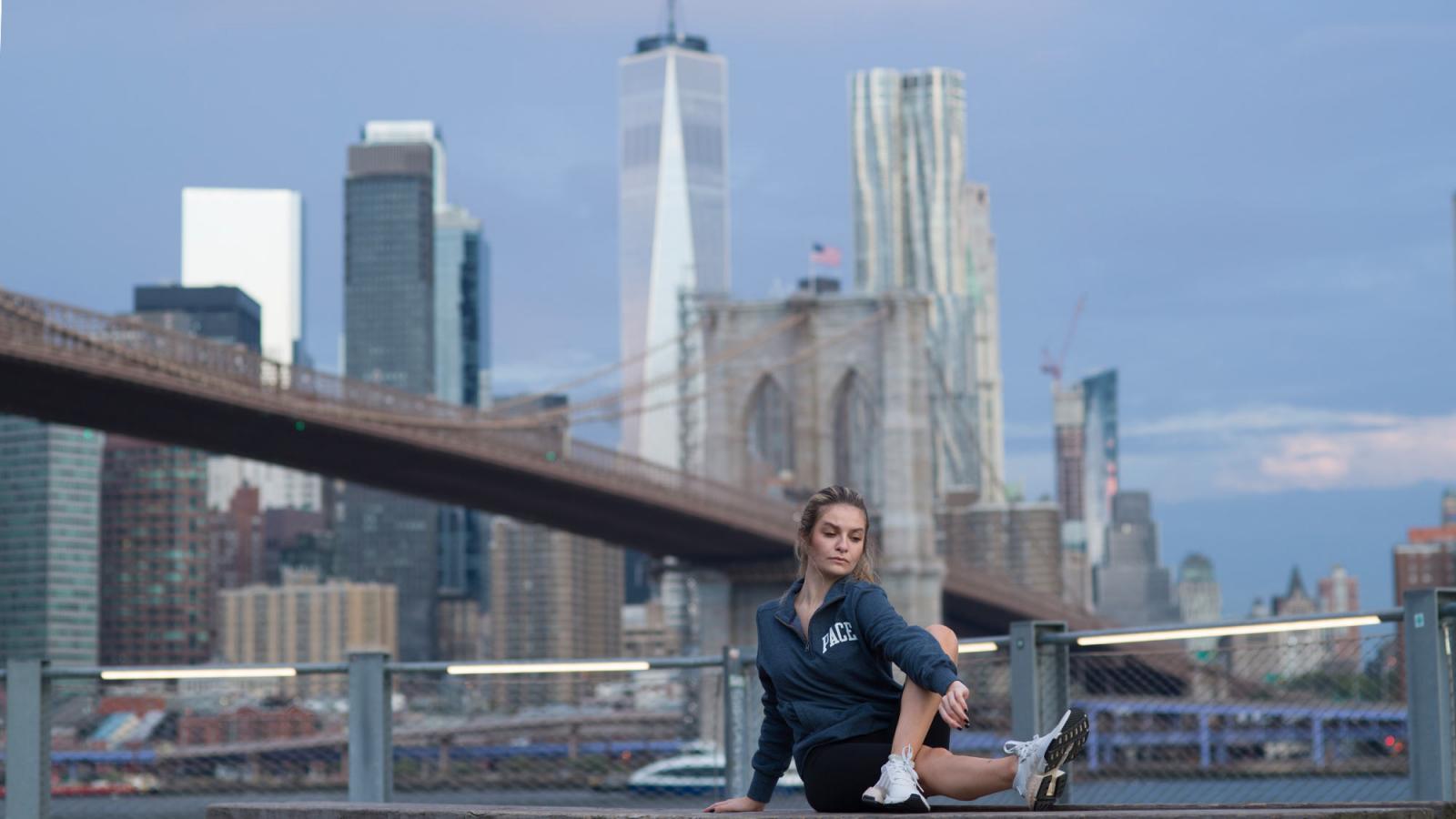
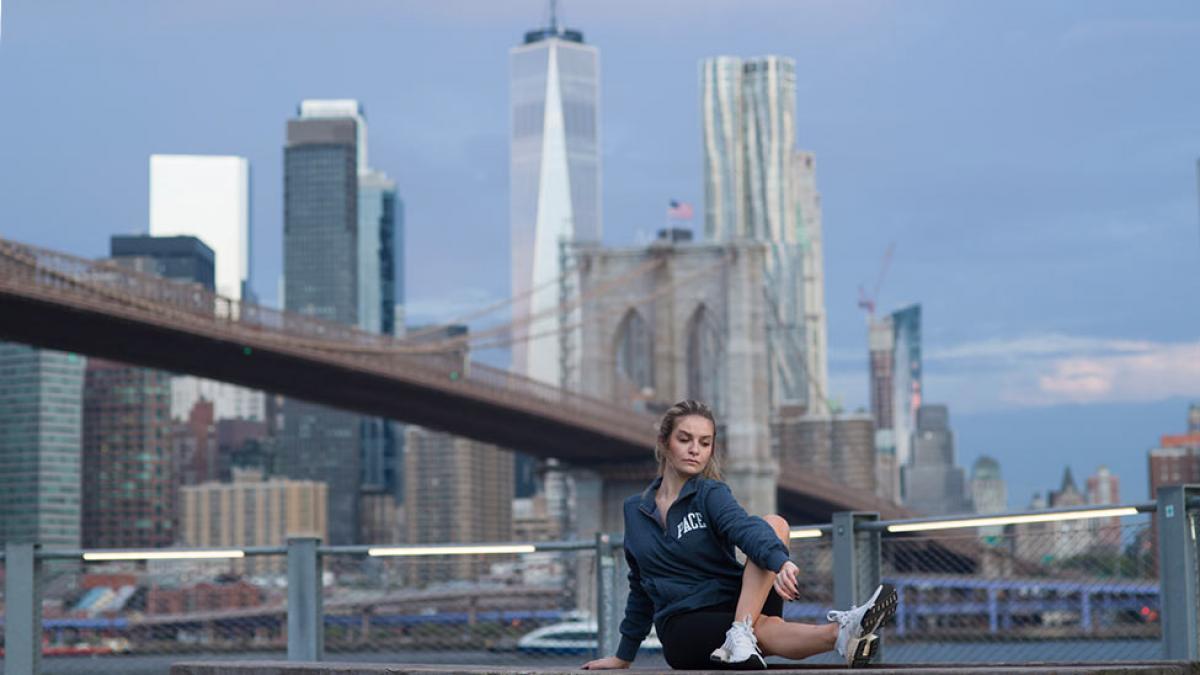
It’s no secret that wellness—physical, mental, spiritual—is a key component to success. At Pace, we’re taking a holistic approach to supporting wellness for all members of our community through the creation of a new role, the Chief Wellness Officer.
Recently, President Krislov’s Mental Health and Well-being Task Force was charged with developing a set of recommendations for addressing the mental health and well-being needs of Pace’s student body and the overall Pace Community. One recommendation from the Task Force was the appointment of a chief wellness officer. The role was envisioned as providing a high-level, holistic vision for all major wellness efforts at the University, including University Health Care, the Counseling Center, and Human Resources.
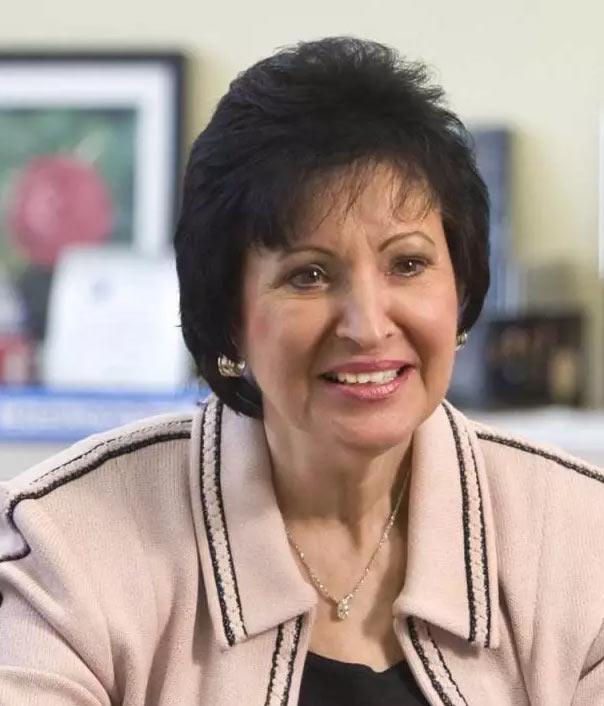
Following her nearly 30 years of service to the University, Harriet R. Feldman, PhD, RN, FAAN, has been appointed as the first Chief Wellness Officer at Pace.
Getting this new office up and running requires expertise on health and wellness, and also familiarity with Pace’s operations, relationships with stakeholders across the University, and the confidence of all University leaders. On all those fronts, Dr. Feldman is exceedingly well qualified.
“I have been conducting a ‘listening tour’ to learn as much as I can about the initiatives and gaps in wellness at Pace,” she wrote in a recent letter to Pace faculty. “I have established an Advisory Committee to work with me on developing a wellness strategic plan and I am particularly interested in focusing on mental health, which affects all members of the Pace community.”
Dr. Feldman will create an audit of our current wellness initiatives and develop a wellness strategic plan, including new initiatives and plans for their implementation. The long-term goal is to improve overall wellness outcomes, with a focus on mental health, among students, faculty, and staff.
Studies have shown a direct correlation between student wellness initiatives and improved student success and retention, which is even more important as we navigate our way to a post-pandemic environment. An increased focus on wellness in our community will ultimately help us do what Pace has always done: create opportunities for our students to succeed.
More from Pace Magazine
Pace is excited to announce that Marcus Tye, PhD, has taken the helm as the dean for the College of Health Professions.
When does a career become passion? When you’re able to use your skills, talent, and education for the greater good. It’s something Harriet Feldman has been doing for more than five decades, starting from her graduation from a diploma nursing school.
Twenty years ago, the Pace Community lost 47 members—students and alumni alike—and was closed for several weeks as we worked toward recovery. To mark the solemn occasion, we asked members of the Pace Community to share their experiences and recollections of the day and the time after.
